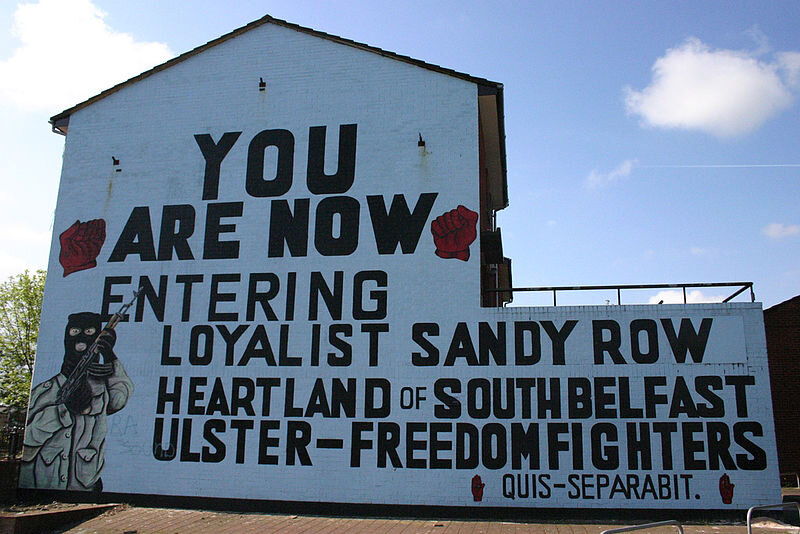Sectarian Violence Erupts in Northern Irish Cities
A street mural marks the entrance of Sandy Row, a Belfast neighborhood and the center of street violence that occurred between April 2 and 5. (Wikimedia)
Violence erupted in Northern Ireland after sunset for the fourth night in a row on April 5. Rioters overwhelmed the police force in the cities of Belfast and Londonderry. Affiliated with pro-U.K. loyalists, the rioters threw petrol bombs and bricks, injuring at least 41 officers. They also hijacked police cars and lit them on fire. Davy Beck, the Chief Superintendent of the Police Service of Northern Ireland, identified the perpetrators as “a number of small disaffected groups who are linked to criminality.”
The riots emerged in response to public outcry after the Public Prosecution Service (PPS) announced on March 30 that it would not prosecute politicians who breached COVID-19 regulations at a funeral in June 2020. More than 2,000 people illegally attended the funeral of Bobby Storey, a former leader in the Irish Republican Army (IRA), a paramilitary group who used guerilla tactics to push for the reunification of Northern Ireland with its southern neighbor, the Republic of Ireland.
The PPS’s decision drew outrage in Northern Ireland. Several politicians accused the PPS of bias towards the biggest Irish nationalist party, Sinn Féin. It should be noted that several Sinn Féin members, including deputy First Minister Michelle O’Neill, were present at the illegal funeral. Infrastructure Minister Nichola Mallon lambasted the Sinn Féin attendees for putting their own desires “above the restrictions, above the law, above the public health advice.”
According to official reports, the riots were led by loyalists, those who strongly believe that Northern Ireland should remain a part of the United Kingdom. Their counterparts, Irish nationalists, believe in Irish reunification. Loyalists tend to be Protestant and of British or Scottish descent, while nationalists tend to be Catholic and of Irish descent. The rioters were also identified as being primarily local youths—the youngest was only 13 years old.
The street violence is reminiscent of a dark past between the two partisan groups. Northern Ireland suffered a long period of violence dubbed “The Troubles,” between the late 1960s up until 1998, during which 3,500 people were killed by nationalist groups, loyalist groups, and the British Army. The Troubles unofficially ended with the 1998 Good Friday Agreement, which granted political representation to the Catholic minority in exchange for a ceasefire. It also led to the demilitarization of the Irish border, which has allowed for seamless trade and travel between the north and the south.
Unfortunately, the U.K.’s departure from the EU on February 1 threatens to reignite tensions between loyalists and nationalists. To this end, fearing nationalist violence in response to a regulated Irish border, Brexit negotiators have allowed Northern Ireland to remain a part of the EU’s single market. This allows easy trade and travel between the north and the south even after the United Kingdom departed the EU. However, this compromise has had unintended consequences. Since Northern Ireland is still within the EU’s single market, custom checks are now required on goods traded between the U.K. and Northern Ireland. Many loyalists believe this compromise will inevitably push Northern Ireland away from the U.K. and towards reunification with its southern neighbor. According to Northern Irish Assistant Chief Constable Mark McEwan, this “growing discontent” among loyalist communities was what manifested in the violent protests in Belfast and Londonderry.
The Northern Irish Assembly will reconvene on April 8 to consider a resolution to formally condemn the violence. Every major party in the Assembly has expressed support for this resolution. However, no formal resolution will prevent sectarian strife from reemerging in Northern Ireland.

